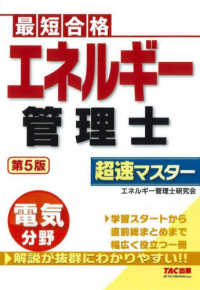- ホーム
- > 洋書
- > 英文書
- > Science / Mathematics
Description
(Text)
This textbook teaches how to design working systems at very high frequencies. It is designed to introduce computer engineers to the design of extremely high speed digital systems. Combining an intuitive, physics-based approach to electromagnetics with a focus on solving realistic problems, the author presents concepts that are essential for computer and electrical engineers today. The book emphasizes an intuitive approach to electromagnetics, and then uses this foundation to show the reader how both physical phenomena can cause signals to propagate incorrectly; and how to solve commonly encountered issues. Emphasis is placed on real problems that the author has encountered in his professional career, integrating problem-solving strategies and real signal-integrity case studies throughout the presentation. Students are challenged to think about managing complex design projects and implementing successful engineering and manufacturing processes. Each chapter includes exercises to test concepts introduced.
(Table of content)
Introduction.- The Basics - Charge, Energy, Time, and Distance.- Practical Matters I - Circuit Boards and Chassis Design, Testing and Debugging Boards.- Gates, Packaging, and Boards: Properties and Modeling.- Circuit Elements: Resistance, Capacitance, and Inductance.- Lumped Analysis: Return Current, Ground Bounce and Ringing.-
(Author portrait)
Samuel H. Russ, Ph.D is an Associate Professor, Dept. of Electrical and Computer Engineering, University of South Alabama








